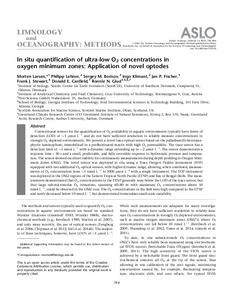In situ quantification of ultra-low O2 concentrations in oxygen minimum zones: Application of novel optodes.

View/
Average rating
votes
Date
2016Author
Larsen, M.
Lehner, P.
Borisov, S.M.
Klimant, I.
Fischer, J.P.
Stewart, F.J.
Canfield, D.E.
Glud, R.N.
Metadata
Show full item recordAbstract
Conventional sensors for the quantification of O2 availability in aquatic environments typically have limits of detection (LOD) of > 1 μmol L−1 and do not have sufficient resolution to reliably measure concentrations in strongly O2 depleted environments. We present a novel trace optical sensor based on the palladium(II)‐benzoporphyrin luminophore, immobilized in a perfluorinated matrix with high O2 permeability. The trace sensor has a detection limit of ∼5 nmol L−1 with a dynamic range extending up to ∼2 μmol L−1. The sensor demonstrates a response time < 30 s and a small, predictable, and fully reversible response to hydrostatic pressure and temperature. The sensor showed excellent stability for continuously measurements during depth profiling in Oxygen Minimum Zones (OMZ). The novel sensor was deployed in situ using a Trace Oxygen Profiler instrument (TOP) equipped with two additional O2 optical sensors, with higher dynamic range, allowing, when combined, measurements of O2 concentr.....
Journal
Limnology and Oceanography MethodsVolume
14Page Range
pp.784-800Document Language
enEssential Ocean Variables (EOV)
OxygenBest Practice Type
Standard Operating ProcedureDOI Original
https://doi.org/10.1002/lom3.10126Citation
Larsen, M.; Lehner P.; Borisov, S.M.; Klimant, I.; Fische, J.P.; Stewart, F.J.; Canfield, D.E.; and Glud, R.N. (2016) In situ quantification of ultra-low O2 concentrations in oxygen minimum zones: Application of novel optodes. Limnology and Oceanography Methods, 14, pp.784-800. DOI:https://doi.org/10.1002/lom3.10126Collections
The following license files are associated with this item:
 Repository of community practices in Ocean Research, Applications and Data/Information Management
Repository of community practices in Ocean Research, Applications and Data/Information Management
